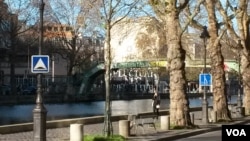On a sunny morning, Ghislene Moret examined the mounds of flowers and notes scattered along Rue de la Fontaine au Roi, where terrorists gunned down nearly half-a-dozen diners earlier this month.
“This is all about love,” she said. “Love overcomes hate. We’re still standing. That is the essential message.”
Attached to a mailbox nearby was a poem written by a 17-year-old Parisian, calling for unity to overcome chaos. Down the street, a message in French by a New Zealander spoke of love in the face of hatred. Next to it, pinned under a glass of red wine, was a note that read: “You will not destroy our way of life. Resist!”
On sidewalks, murals and makeshift memorials for the nearly 500 dead and wounded in this month’s carnage — but also on Twitter, Instagram, Facebook and blogs — French are finding solace through art. Today the outpouring of graffiti, poetry and music is helping to heal a wounded nation.
There’s Patrick Jardry, who headed out hours after the November 13 attacks with flowers and a few choice phrases from what he calls his "personal prophet."
“I put a rose in front of each of the places where the attacks took place,” said Jardry, who was back this past weekend revisiting a Cambodian restaurant and bar where more than a dozen people died in a hail of gunfire. “I also left phrases from Victor Hugo.”
Asked for an example, he quoted from Hugo’s Deeds and Words, referring to the 1870 siege of Paris during the Franco-Prussian war: "Paris is the sacred city — who attacks Paris attacks the entire human race."
“Everything is said there,” he added. “Poetry is a language these terrorists cannot understand. But it’s not for them. It’s for us.”
‘Tossed but not Sunk’
Around the city, graffiti artists are spray painting the ancient motto of Paris, Fluctuat Nec Mergitur, Latin for “Tossed but not Sunk,” carrying the emblem of a ship. Politicians and poets are tweeting their favorite odes and their own compositions. Bloggers have posted photos of their favorite street art on the Internet and musicians have composed songs for the Paris victims.
The artistic outpouring is happening around the country. Murals in the eastern city of Strasbourg and the southwestern town of Biarritz count among myriad post-attack street art gathered under the #SprayForParis hashtag. A park wall in Valenciennes bears a giant mural of the capital, and local trains in the northern Pas de Calais region are daubed in colorful, defiant graffiti.
Nestled amid the piles of flowers and gutted candles in front of Le Petit Cambodge restaurant, where Jardry made his pilgrimage, are lyrics from Douce France (Sweet France) by French singer Charles Trenet, a poem by George Brassens, and a more contemporary sampling from slam artist Grand Corps Malade. Scrawled on a piece of wilted white paper nearby is a passage from Song of Myself, by 19th century New York poet Walt Whitman, next to an empty bottle of Brooklyn Brewery beer.
“All this tells me French will not be cowed by terrorists,” said American Stuart Scott, here for the Paris climate talks, as he paused to read the messages. “The poetry and images that are here, but also the very strong increase in security, French are making their statement in both ways, they will be strong in heart and in arms.”
Resisting through culture
To be sure, writers and artists also took to their pens after January’s attacks in Paris, as Je suis Charlie quickly became an international rallying cry for free expression and the irreverent satire of the slain French cartoonists. But this latest round of slayings has touched a broader slice of the population — sparking wider soul searching about what French culture and values are all about.
“This shows that we can resist by our culture, by our words, by our ideas,” said Paris area resident Laetitia Gaspar, who counted among a crowd studying the messages piled up at Place de la Republique, under a giant statue of Marianne.
On a board nearby was a message reading “Kabylia is Paris” and a long poem, reflecting the ethnic Algerian roots of some city residents.
Not all the art is uplifting.
Some graffiti makes vulgar remarks against the Islamic State group that has claimed responsibility for the attacks. Others are bitingly playful — like the cartoons of Asterix and Obelix fighting IS next to the Eiffel Tower, posted on Facebook by Italian artist AleXandro Palombo.
“For me, it’s the barbarity and the horror that comes out,” said Parisian Raymond Moisa, making his own art tour around the Paris attack sites.
But Berlin resident Maida Schmidt, who contemplated the giant Flutuat mural towering over Republique square, disagreed.
“What has impressed me the most is that everything after the attacks is about poetry,” she said, “the most beautiful poetry.”







